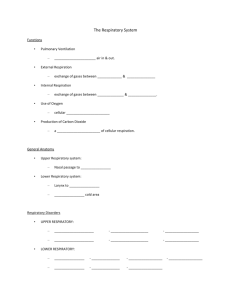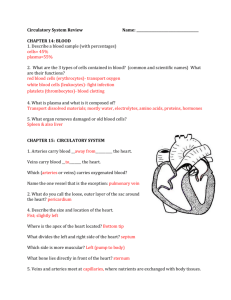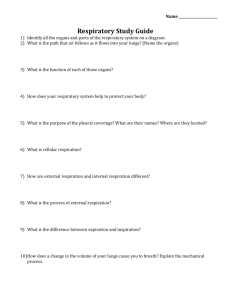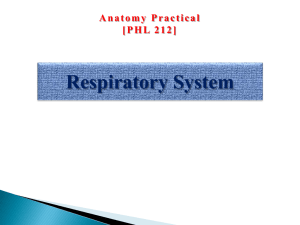Chapter 22 Respiratory System
advertisement
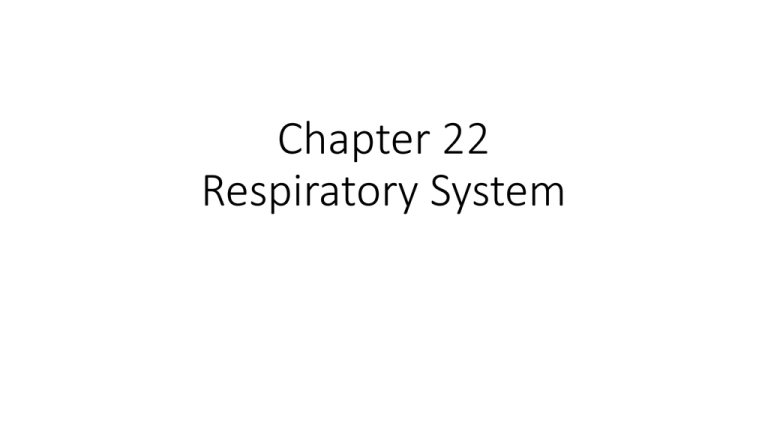
Chapter 22 Respiratory System Function of the Respiratory System • Supply the body with oxygen and dispose of carbon dioxide Four Processes of Respiration • Pulmonary ventilation • External respiration • Transport of respiratory gases • Internal respiration Pulmonary Ventilation • Movement of air into and out of lungs so that the gases are constantly being exchanged and refreshed. • Commonly known as breathing. External Respiration • Movement of oxygen from the lungs to the blood and of carbon dioxide from the blood to the lungs Transport of Respiratory Gases • Transportation of oxygen and carbon dioxide in the body. • Oxygen from the lungs to the capillaries (cells) • Carbon dioxide from the capillaries to the lungs (cells) Internal Respiration • Movement of oxygen from the blood to the tissue cells and of carbon dioxide from the tissue cells to the blood. Respiration • Only the first two processes are the actual responsibility of the respiratory system, but it can’t accomplish its primary goal unless the 3rd and 4th processes are also occurring! • The respiratory and circulatory systems are closely coupled! Parts • Nose, pharynx (throat), larynx (voice box), trachea (windpipe), bronchi, and lungs. Parts of the Respiratory System • Nose & nasal cavity • Only external part of the respiratory system. • Provides an airway for respiration. • Moistens, warms and filters air. • Resonating chamber for speech • Has olfactory (smell) receptors. Nasal Cavity • Space within internal nose • Cavity is divided by the nasal septum • During breathing air enters the cavity by passing through the nostrils (external nares). Nasal Conchae • Superior, middle, and inferior • Protrude medially from the lateral wall in the nasal cavity (like shelves) • Greatly increase the surface area and enhance air turbulence • gases swirl and turn, the heavier particles fall out and become trapped in mucous covering the “shelves” Paranasal Sinuses • Surround the nasal cavity • Located in the frontal, sphenoid, ethmoid, and maxillary bones. • “Spaces” in the facial bones • Lighten skull • Warm and moisten air • Produce mucous – flows into the nasal cavity. • Blowing your nose helps drain the sinuses. Paranasal Sinuses Homeostatic Imbalance • Viruses, streptococcal • Sinusitis bacteria, allergens can • When the passageways to the cause rhinitis sinuses are blocked, the air in the • inflammation of the nasal cavity is absorbed causing a mucosa that is partial vacuum and a sinus accompanied by excessive headache mucus production, congestion and postnasal drip. Pharynx • AKA - Throat. • Muscular tube extending from behind the nasal cavity to the larynx • Passageway for food and air, resonating chamber for speech, houses tonsils Pharynx • Three regions: • A) nasopharynx • B) oropharynx • C) laryngopharynx A B C Larynx • AKA - Voice box • 3 main functions: • Provides an open airway • Acts as a switching mechanism for food and air. • Sound production Anatomy of Larynx - Epiglottis • Flexible, spoon shaped piece of elastic cartilage that covers the larynx when swallowing • Keeps everything going down the correct “tube” • If anything other than air enters the larynx, the cough reflex is triggered Epiglottis Glottis • The “hole” seen at the opening of the larynx. • On either side you will see 2 strips of membranous tissue vocal cords (sound production) appear white because lack blood vessels. Glottis • False vocal cords – above and lateral to the vocal cords. • Play no part in sound production but help close the glottis when we swallow
